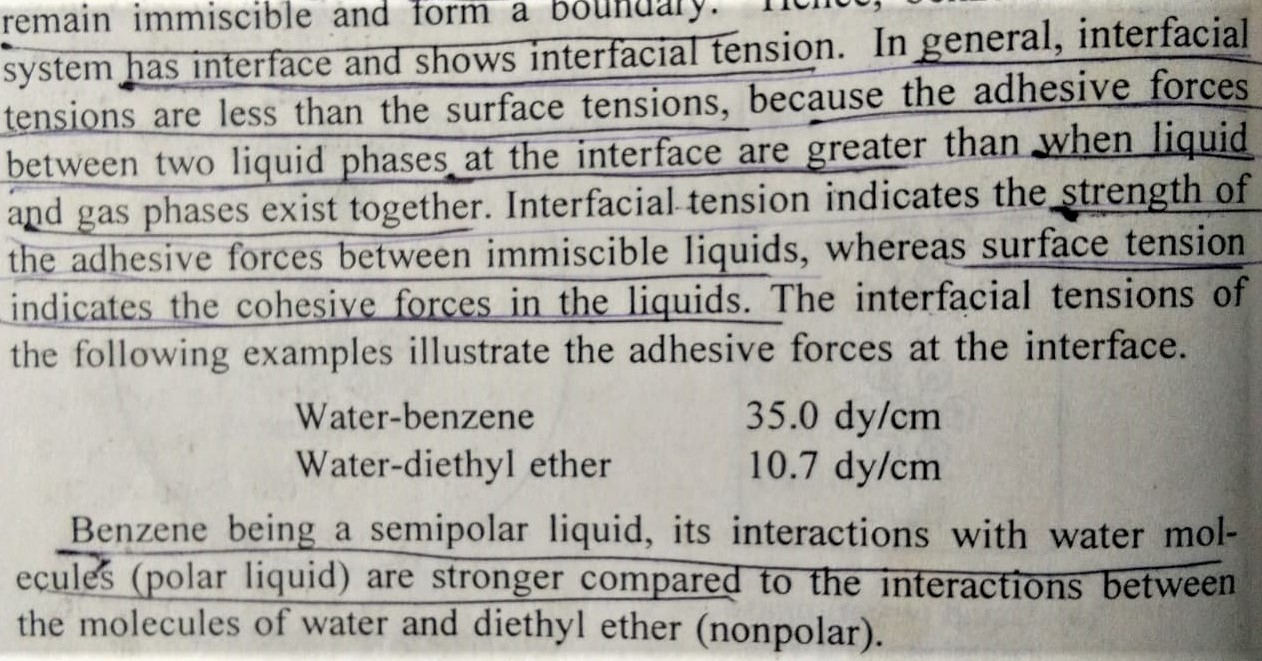Physical Pharmacy Assignment
- Define interface and inter-facial phase.
- Give applications of interfacial phenomena in pharmacy.
- Classify interfaces with examples.
- Define surface tension with units and examples.
- Give applications of surface tension phenomena.
- Define cohesive and adhesive forces.
- Explain concept of surface tension with diagram.
- Define interfacial tension with units & examples.
- Explain why interfacial tensions are less than surface tension.
- Why Surface tension of liquid in zero at critical temperature.
- Why liquid drop assumes spherical shape when suspended in air.
- Why interfacial tension of benzene-water is lower than carbontertachloride-water?
- Explain: The higher the surface tension of liquid, the stronger are the cohesive forces of that liquid.
- Define interface and inter-facial phase.
When Phases exist together, the boundary between two of them is known as an interface. The properties of the molecules forming the interface are often sufficiently different from those in the bulk of each phase that they are referred to as forming an inter-facial phase.
If a liquid and its vapors exist together in the same container, the liquid takes the bottom part of the container. The remainder of the container is filled up by the liquid vapor, which, as with any gas, had a tendency to take all available space.
2. Give applications of inter-facial phenomena in pharmacy.
Every physical entity, let it be a cell, a bacterium, a colloid, a granule, or a human, possesses an interface at its boundary with its surroundings, the importance of the present topic is self-evident.
Interfacial phenomena in pharmacy and medicine are significant factors that affect adsorption of drugs onto solid adjuncts in dosage form, penetration of molecules through biologic membranes, emulsion formulation and stability, and the dispersion of insoluble particles in liquid media to form suspensions.
The interfacial properties of a surface-active agents lining the alveoli of the lung are responsible for the efficient operation of this organ. Several authors have reviewed the relationship between surface properties of drugs and their biologic activity.
3. Classify interfaces with examples.
This “tension” in the surface is the force per unit length that must be applied parallel to that surface so as to counterbalance the net inward pull.
This force, the surface tension, has the units of dynes/cm in the CGS system and of N/m in the SI system.
5. Give applications of surface tension phenomena.
Surface tension is an important physicochemical property and a characteristic of liquid. The phenomenon of surface tension is responsible for the followinf processes.
- formation of spherical globules in emulsions
- formation of nearly spherical shape of falling water droplets
- formation of spherical shape of mercury particles on a flat surface
- rise of liquid in a capillary tube
- formation of hemispherical surface, i.e., lower meniscus, when water is filled in a glass tube.
6. Define cohesive and adhesive forces.
In a liquid, molecules experience greater attraction from the neighboring molecules. Such inter-molecular attractions between like molecules are called cohesive forces while attractions between unlike molecules are called adhesive forces. Surface denotes the cohesive forces of interaction in a liquid.
7. Explain concept of surface tension with diagram.
Consider an example of water in a beaker. A molecule present in the bulk phase of water (say B) is attracted equally from all sides by neighboring molecules. Therefore, a molecule in the bulk of the solution in distributed more or less symmetrically. Hence the net pull (forces) acting on the molecule B in zero.
Now consider a molecule say ‘S’ that lies on the surface. It is partially surrounded by other molecule say ‘S’ that lies on the surface. It is partially surrounded by other molecules. There are no molecules above it. This molecule is attracted by the molecules below it and experiences downward pull. The adhesive forces between the molecule S and the sir above it are weaker than the cohesive forces and cannot balance the inward pull on molecule ‘S’. These unbalanced molecule acting downward tend to draw the surface molecules into the bulk of the liquid.








